Thyme is a Mediterranean herb widely used to flavor roasted dishes, soups, stews, and fresh salads too. Easy to grow and naturally pest repellant, it’s no wonder why thyme is a popular herb to grow in large herb gardens, as well as indoor pots.
But while many gardeners are familiar with common thyme, there are actually a number of different edible thyme species, which are just as tasty and fun to grow!
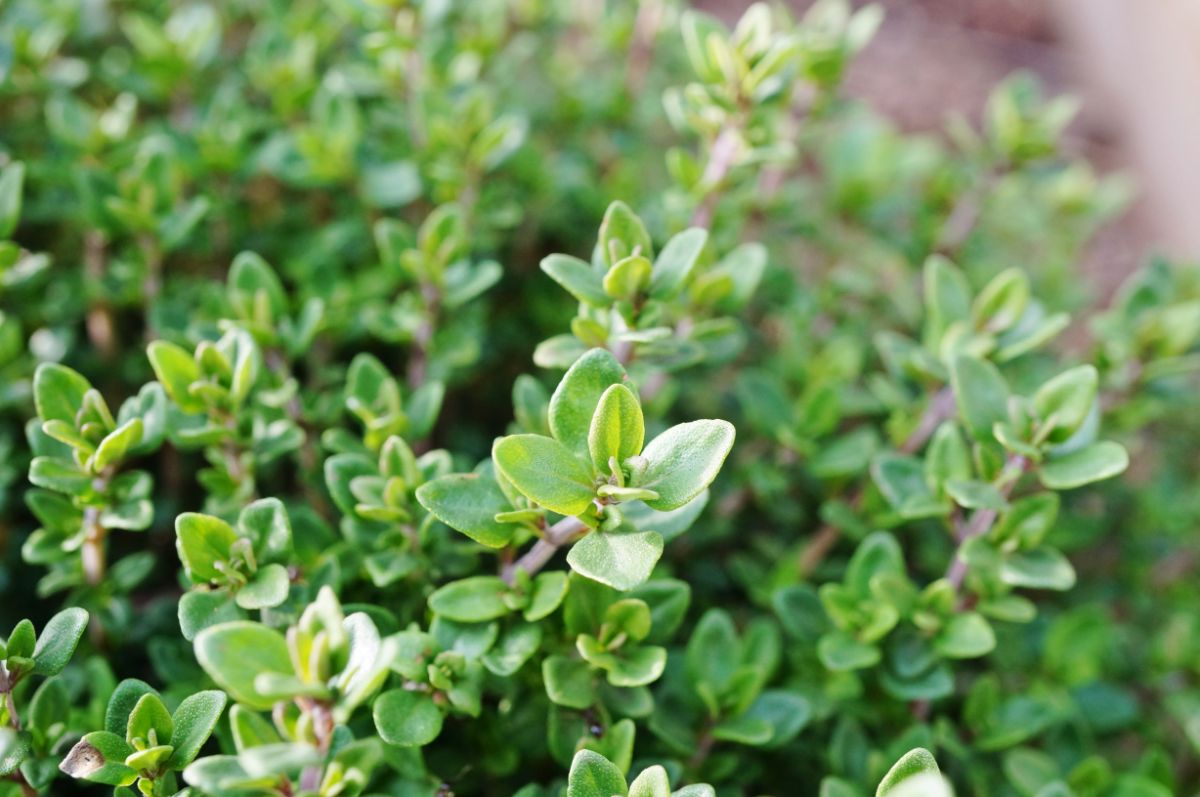
In this guide, we’ll introduce you to some of our favorite thyme cultivars. These plants are all relatively easy to keep, small space friendly, and delicious too! So if you are ready to expand your thyme horizons, read on and discover new and unique thyme plants to grow in your garden this growing season.
Jump to:
- 13 types of edible thyme for your herb garden or foodscape
- 1. Common thyme (Thymus vulgaris)
- 2. Lemon thyme (Thymus citriodorus)
- 3. Caraway thyme (Thymus herba-barona)
- 4. French thyme (Thymus vulgaris ‘French’)
- 5. German thyme (Thymus vulgaris ‘German’)
- 6. Creeping thyme (Thymus serpyllum)
- 7. Orange balsam thyme (Thymus vulgaris 'Orange Balsam')
- 8. Lavender thyme (Thymus vulgaris thracicus)
- 9. Woolly thyme (Thymus pseudolanuginosus)
- 10. Mother of thyme (Thymus praecox)
- 11. Pennsylvania Dutch tea thyme (Thymus pulegioides)
- 12. Juniper thyme (Thymus leucotrichus)
- 13. Mediterranean thyme (Thymbra spicata)
- Frequently asked questions
- Summary
13 types of edible thyme for your herb garden or foodscape

Like many of our other favorite edible herbs, thyme belongs to the mint family, and it can grow quickly under the right conditions. Many varieties of thyme are grown exclusively for edible use, but thyme plants are also surprisingly beautiful, and they attract pollinators to your garden if you allow them to bloom. What’s more, some thyme plants can also be used as low-maintenance groundcovers for even more garden variety!
1. Common thyme (Thymus vulgaris)

| Plant name: | Common thyme |
| Light requirements: | Full sun to light shade |
| Watering requirements: | Moderate to low |
| Growing zone: | Zones 4 to 8 |
| Notable features: | A popular pick among home gardeners |
Also known as English thyme or garden thyme, common thyme is a popular type of thyme to grow in home gardens, and it’s the thyme variety you’re most likely to encounter at the grocery store. Sumptuously rich and fragrant, common thyme is the perfect addition to roast meat and vegetable dishes, but it can also be worked into stews, cabobs, and fresh salads. When used in cooking, common thyme is usually gathered up into bunches or added as whole springs, but common thyme leaves can also be removed from the stem and chopped finely, depending on how you intend to use them.
Common thyme is native to southwestern Europe and Italy, but it’s a cold hardy plant that can remain evergreen in zones as chilly as zone 4. Often grown in inground herb beds, common thyme is also compact enough for container growing, and it can even be kept on a kitchen windowsill garden. And while this plant is mostly known for its bluish-green leaves, common thyme also blooms pinkish-purple to white leaves in early to mid-summer, which are always a hit with bees!
2. Lemon thyme (Thymus citriodorus)
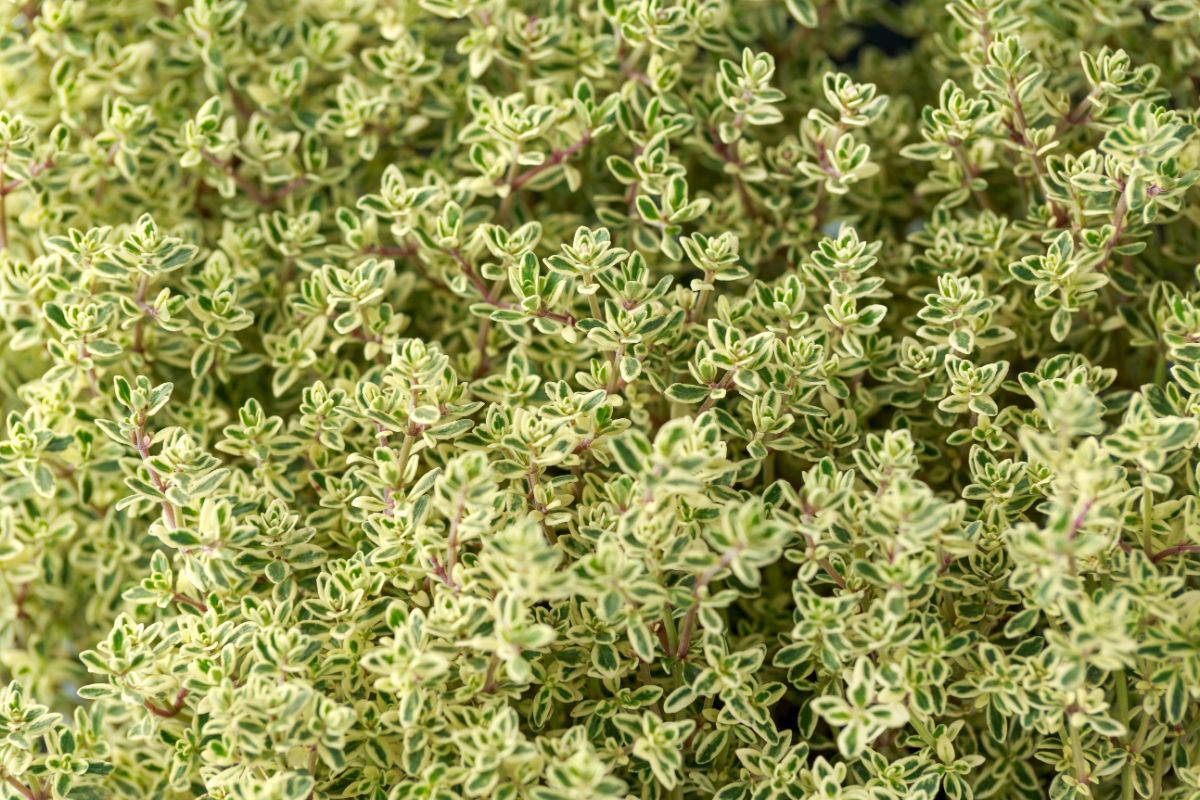
| Plant name: | Lemon thyme |
| Light requirements: | Full sun |
| Watering requirements: | Moderate to low |
| Growing zone: | Zones 5 to 9 |
| Notable features: | Notes of lemon flavor |
Lemon thyme is an interesting thyme variety that’s primarily known for its bright, lemony flavor. Since lemon thyme is rarely sold at grocery stores, if you want to use this herb in your cooking, you’ll likely need to grow it yourself. Like other varieties of thyme, lemon thyme is slow to grow from seed, so most gardeners grow it from nursery starts or stem cuttings.
People once believed that lemon thyme was another variant of common thyme; however, DNA studies on the plant confirmed that lemon thyme is its own unique species (Thymus citriodorus). Native to the Mediterranean, lemon thyme grows best in full sun, but it can tolerate light shade if needed. Just keep in mind that thyme plants grown in shady areas won’t grow or bloom as prolifically.
Tip: For even more herb garden color, look for variegated thyme options, like ‘Silver Queen’ lemon thyme!
3. Caraway thyme (Thymus herba-barona)
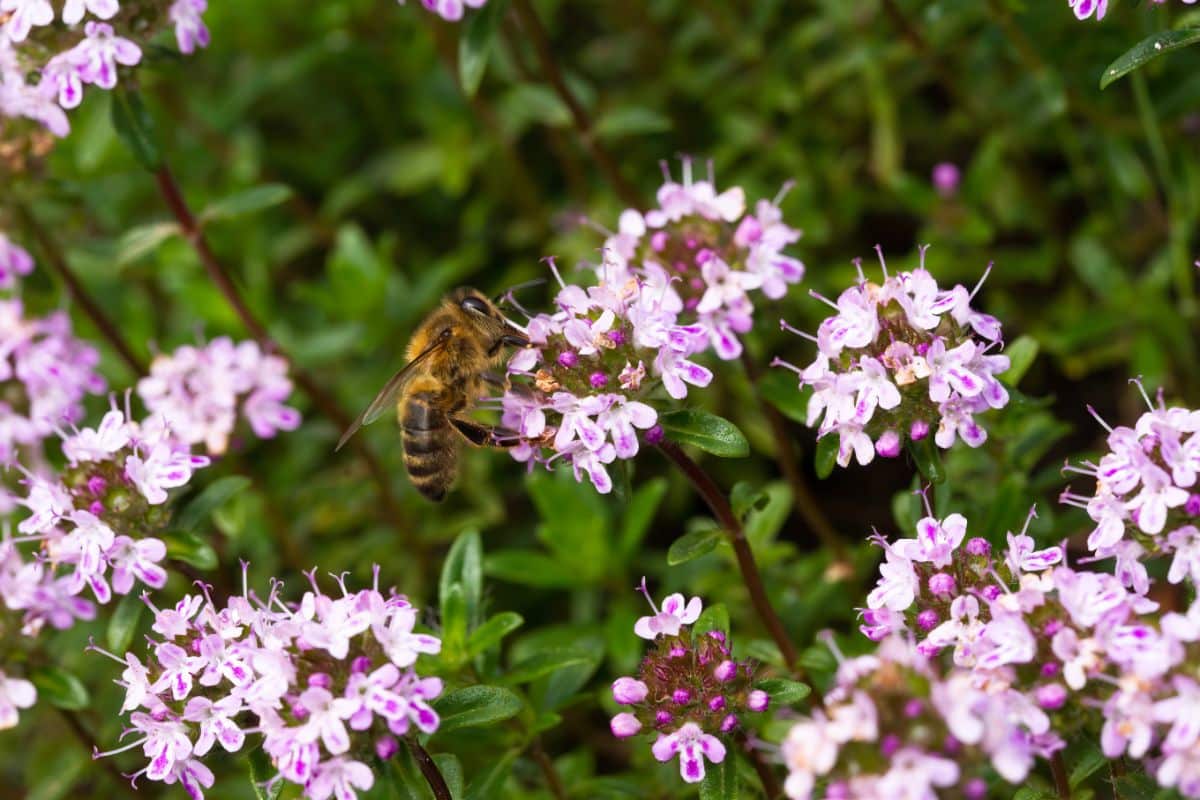
| Plant name: | Caraway thyme |
| Light requirements: | Full sun |
| Watering requirements: | Moderate to low |
| Growing zone: | Zones 4 to 8 |
| Notable features: | Notes of caraway flavor |
A true foodie’s thyme, caraway thyme has that delightful thyme flavor but with interesting notes of caraway, which makes this herb standout. The plant’s Latin name comes from the fact that caraway thyme was historically used to flavor an English beef dish known as “The Baron.” However, while caraway thyme is delicious with meat dishes, it can also be used to flavor veggies, casseroles, and more!
Because caraway thyme is so distinctly flavored, you may want to use just a little bit of this herb at a time to see if you like the taste or not. This plant is native to Sardinia and Corsica, but it is hardy in growing zones 4 to 8. Like other thyme plants, caraway thyme can grow in nutrient-poor soils, but it’s specially adapted to well-draining, sandy earth.
4. French thyme (Thymus vulgaris ‘French’)
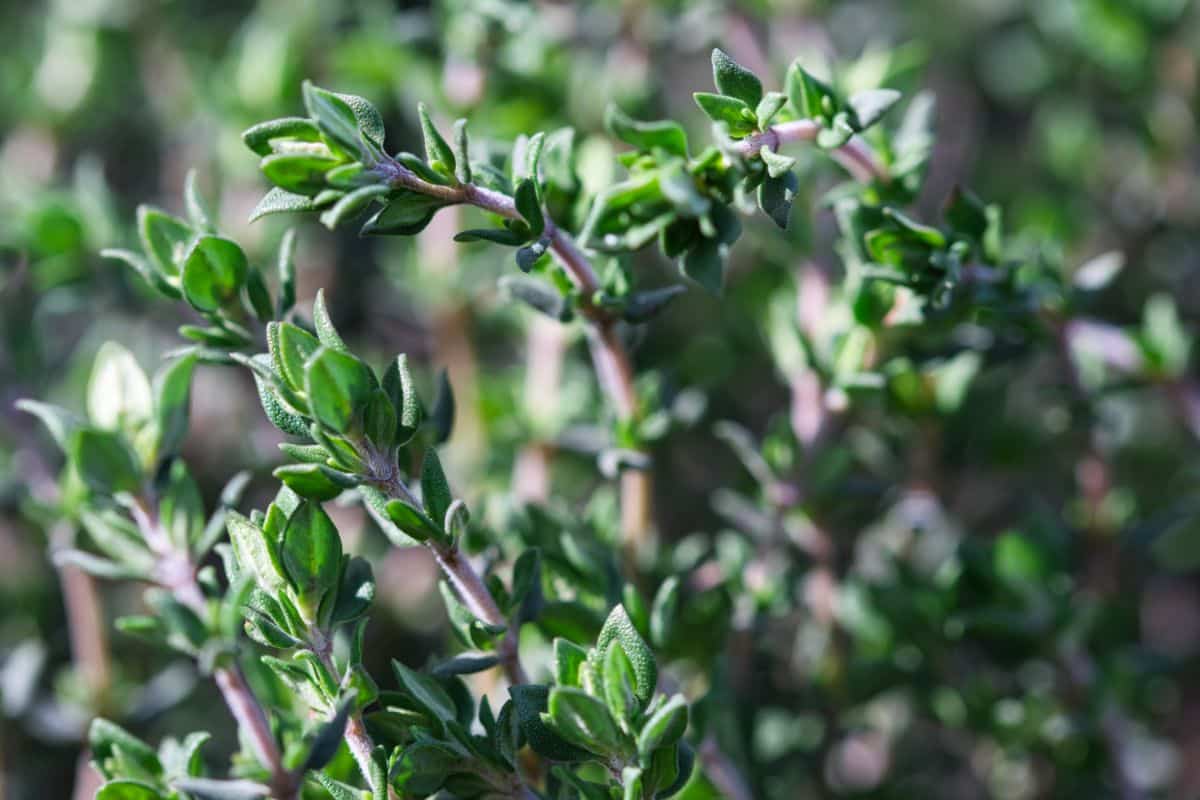
| Plant name: | French thyme |
| Light requirements: | Full sun to light shade |
| Watering requirements: | Moderate to low |
| Growing zone: | Zones 5 to 9 |
| Notable features: | Subtler flavor than common thyme |
French thyme is a variety of common thyme, but this cultivar isn’t quite as cold hardy as common thyme, and it only overwinters in zones 5 and up. This plant also grows a bit larger than common thyme, but it’s still compact, and it maxes out at around 8 to 12” high when mature. These plants also have a grayish hint to their narrow leaves, but their pink flowers are equally attractive to pollinators!
Also sometimes known as summer thyme, French thyme has a slightly sweeter and subtler flavor than common thyme, but it’s just as delicious, and it can be used in any recipe where you’d normally use common thyme. However, if you enjoy authentic French cooking, French thyme is the cultivar you want to have on hand! Like common thyme, French thyme is a relatively popular cultivar, so you shouldn’t have any trouble tracking it down at your local plant nursery.
5. German thyme (Thymus vulgaris ‘German’)
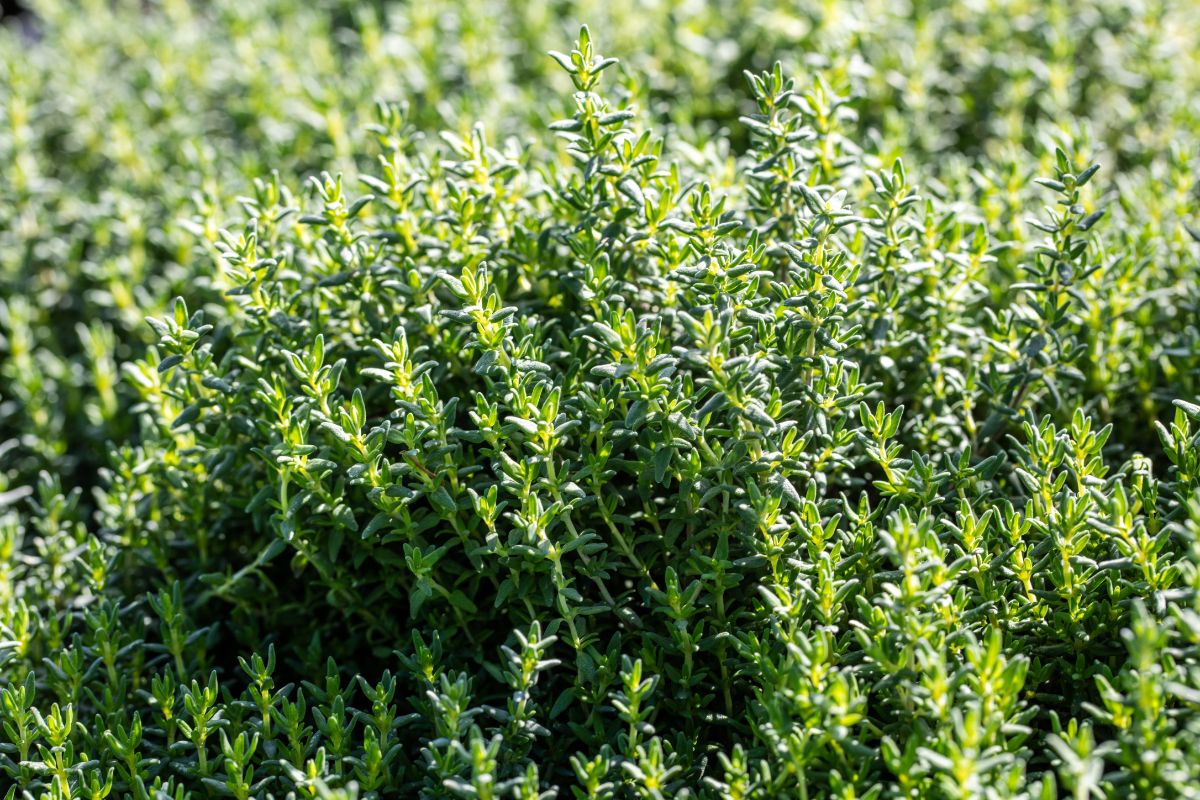
| Plant name: | German thyme |
| Light requirements: | Full sun to light shade |
| Watering requirements: | Moderate to low |
| Growing zone: | Zones 3 to 9 |
| Notable features: | Earthier flavor than common thyme |
Another variation of common thyme, German, is slightly hardier than French thyme, and it’s generally grown in USDA growing zones 4 through 9. That said, this tough-as-nails plant can sometimes overwinter in areas as frigid as zone 3, making it a fine choice for thyme lovers in even the chilliest climates! While this plant looks very similar to both French and common thyme, German thyme has slightly rounder leaves, and its stems lack any reddish coloration.
Flavor-wise, German thyme is very similar to common thyme, but it tastes a bit earthier and muskier. A top pick for flavoring soups, salads, and hearty winter fare, German thyme can also be brewed into cozy herbal teas with a bit of honey, or it can be dehydrated and stored on your spice rack. If you do decide to dry thyme for pantry use, keep the dried stems whole and only crush or powder them right before you intend to use them, as this will preserve that pungent, thyme-y flavor!
6. Creeping thyme (Thymus serpyllum)
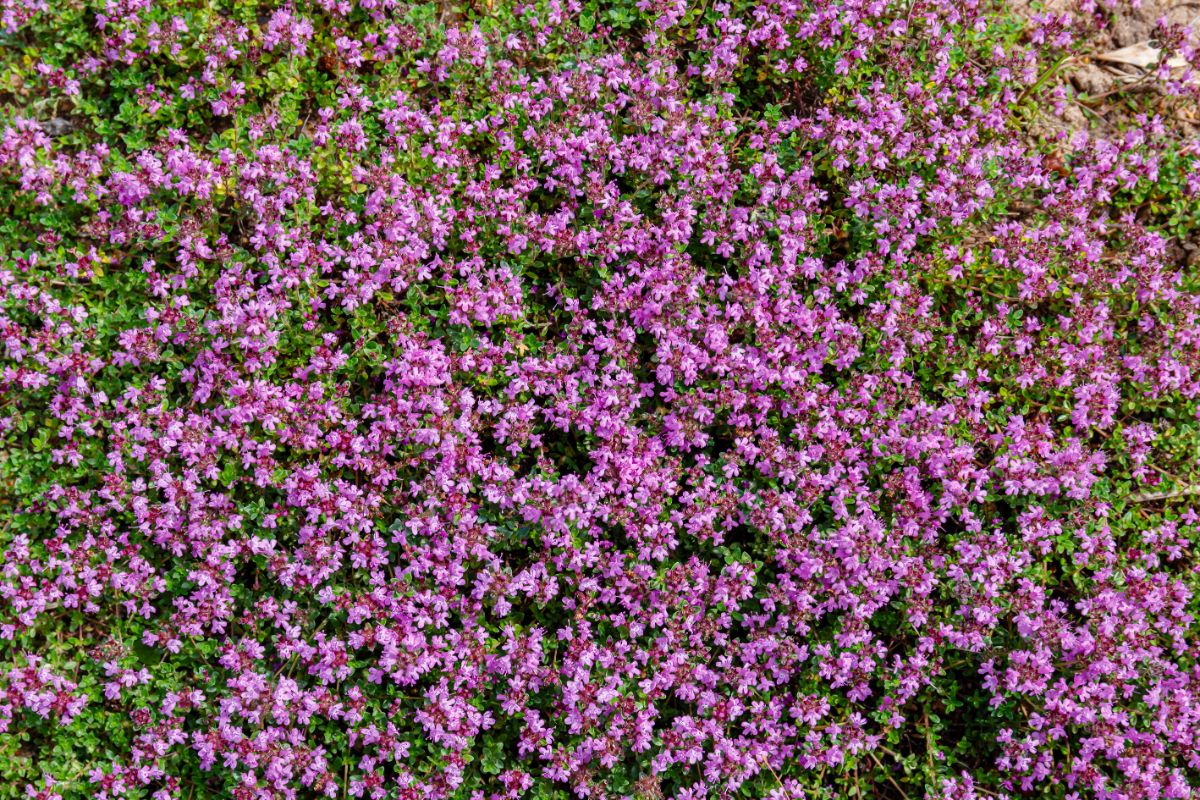
| Plant name: | Creeping thyme |
| Light requirements: | Full sun to light shade |
| Watering requirements: | Moderate to low |
| Growing zone: | Zones 4 to 9 |
| Notable features: | Flowering and edible groundcover; Drought-resistant grass alternative; Good for pollinators |
Creeping thyme is mostly grown as an ornamental, and it makes a fantastic, low-maintenance groundcover for sunny areas. But this plant is technically edible, and it can be used just like standard common thyme in any dish. That makes creeping thyme a multi-purpose herb, and, of course, bees love creeping thyme too!
Creeping thyme can be grown in herb gardens to suppress weeds and add extra color; however, this pint-sized plant is also small enough to keep in containers. For even more planting options, creeping thyme can be grown as a drought-tolerant grass alternative for lawns, and its trailing growth habit can be used to conceal unsightly retaining walls or fill in space in garden walkways. While creeping thyme plants can be grown on their own, these spreading herbs look best when they’re planted en masse, but plants should be spaced at least 12” apart so they have plenty of room to spread.
7. Orange balsam thyme (Thymus vulgaris 'Orange Balsam')
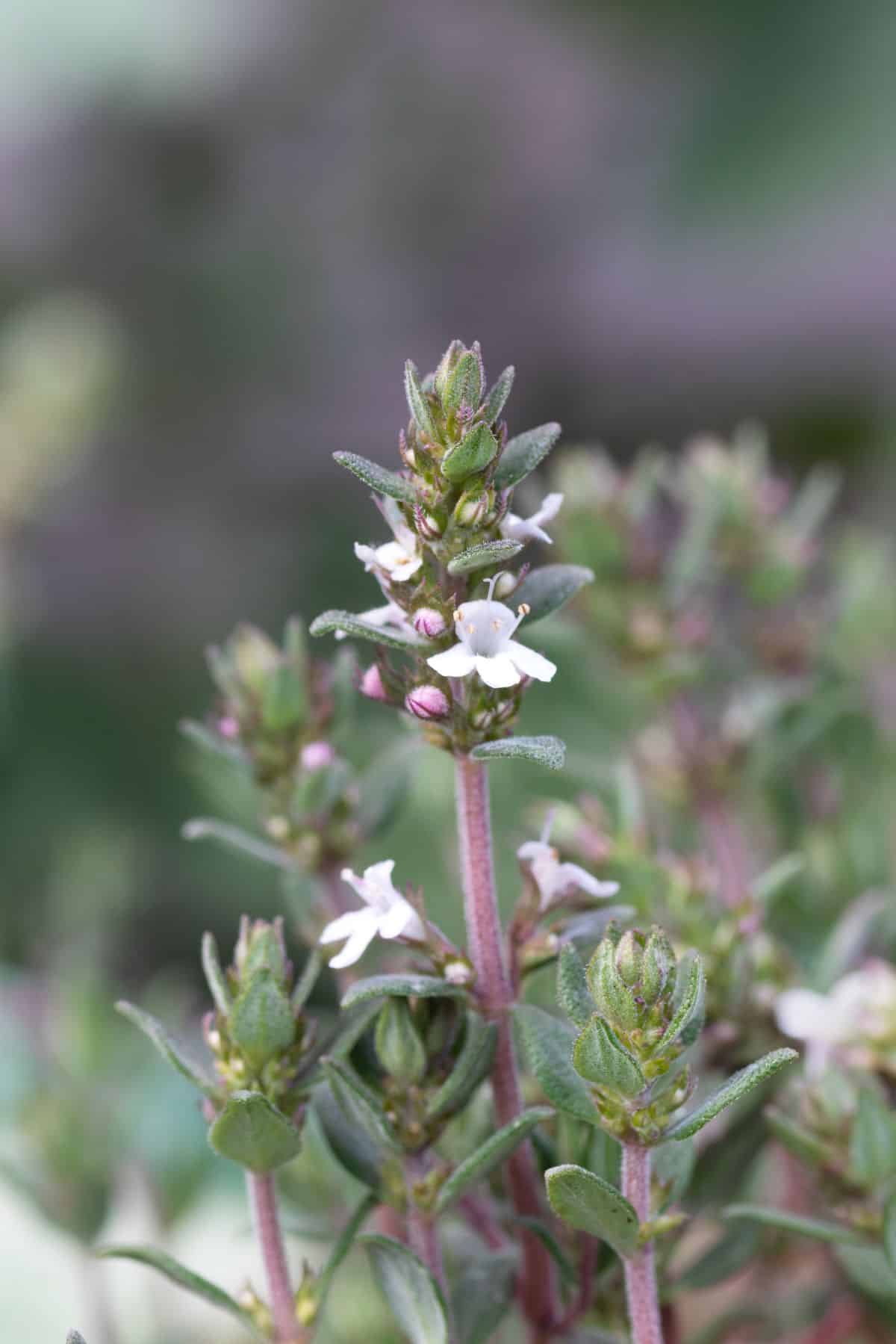
| Plant name: | Orange balsam thyme |
| Light requirements: | Full sun to light shade |
| Watering requirements: | Moderate to low |
| Growing zone: | Zones 5 to 11 |
| Notable features: | Notes of orange flavor |
If you love the idea of growing citrus-flavored thyme plants, lemon thyme is a good choice… but you can also try out orange balsam thyme. This flavorful thyme option has a robust thyme flavor but with distinct notes of sweet orange. Fragrant and delicious, orange balsam thyme can be used to flavor sauces, teas, savory dishes, and even sweet treats and candies too!
Technically a variety of common thyme, orange balsam thyme has an upright growth habit, and it generally grows to about 4 to 12” in height. Like other thyme plants, orange balsam thyme can become woody if it’s not harvested or pruned often, but you can keep your plant looking trim by cutting it back at least once a year. If you want to harvest large quantities of thyme at once, the best time to do it is in spring or early summer, right before the plant flowers.
8. Lavender thyme (Thymus vulgaris thracicus)
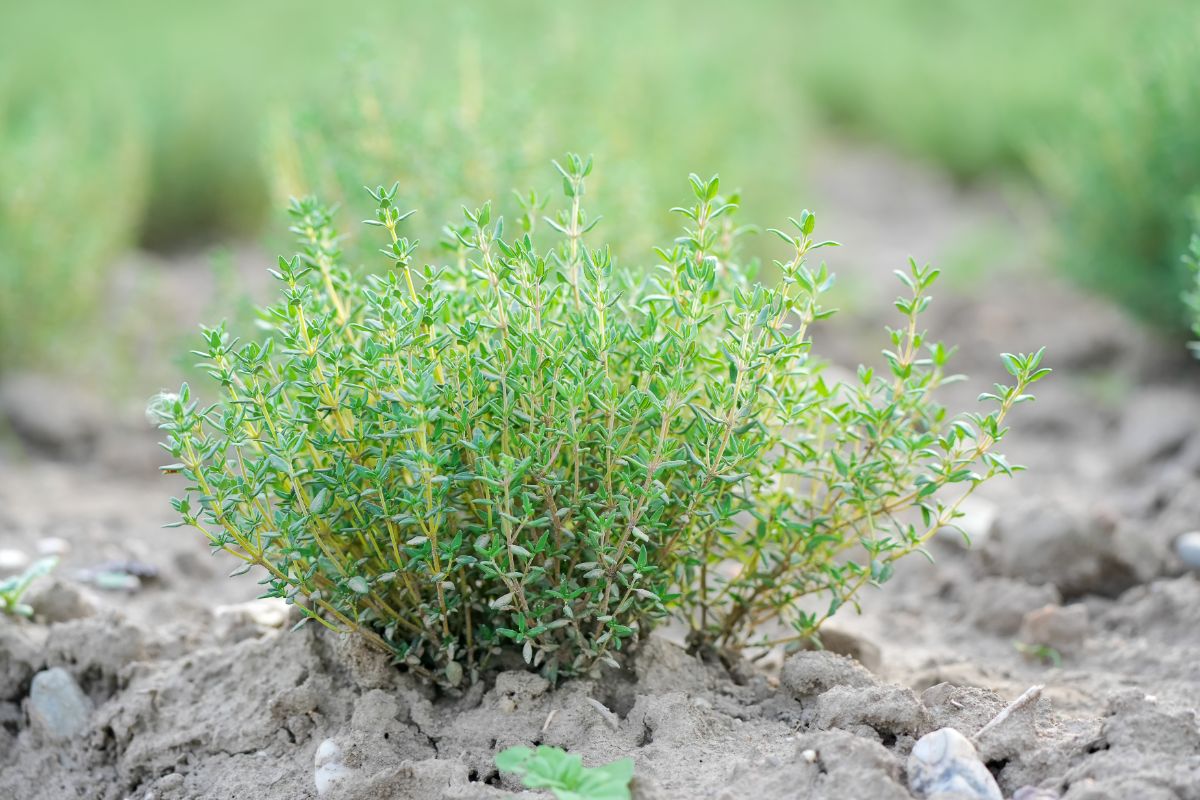
| Plant name: | Lavender thyme |
| Light requirements: | Full sun |
| Watering requirements: | Moderate to low |
| Growing zone: | Zones 5 to 11 |
| Notable features: | Lavender-like aroma |
An unusual thyme variety, lavender thyme is prized for its dense, mounding grown habit and fragrant, needle-like leaves. Another edible thyme option, lavender thyme has that savory thyme flavor but has a delicate aroma that’s reminiscent of lavender. An excellent choice for herbal teas and potpourri making, lavender thyme can also be used as low-maintenance groundcover, and it looks spectacular in rock gardens too.
Lavender thyme generally blooms in May, and when the plant is in flower, it’s highly attractive to all sorts of pollinators. However, if you want to harvest lavender thyme as an edible, the best time to do it is right before the plant flowers. At this point in the growing season, the plant’s leaves will have the highest concentration of oils, and they’ll have the strongest taste and aroma.
9. Woolly thyme (Thymus pseudolanuginosus)
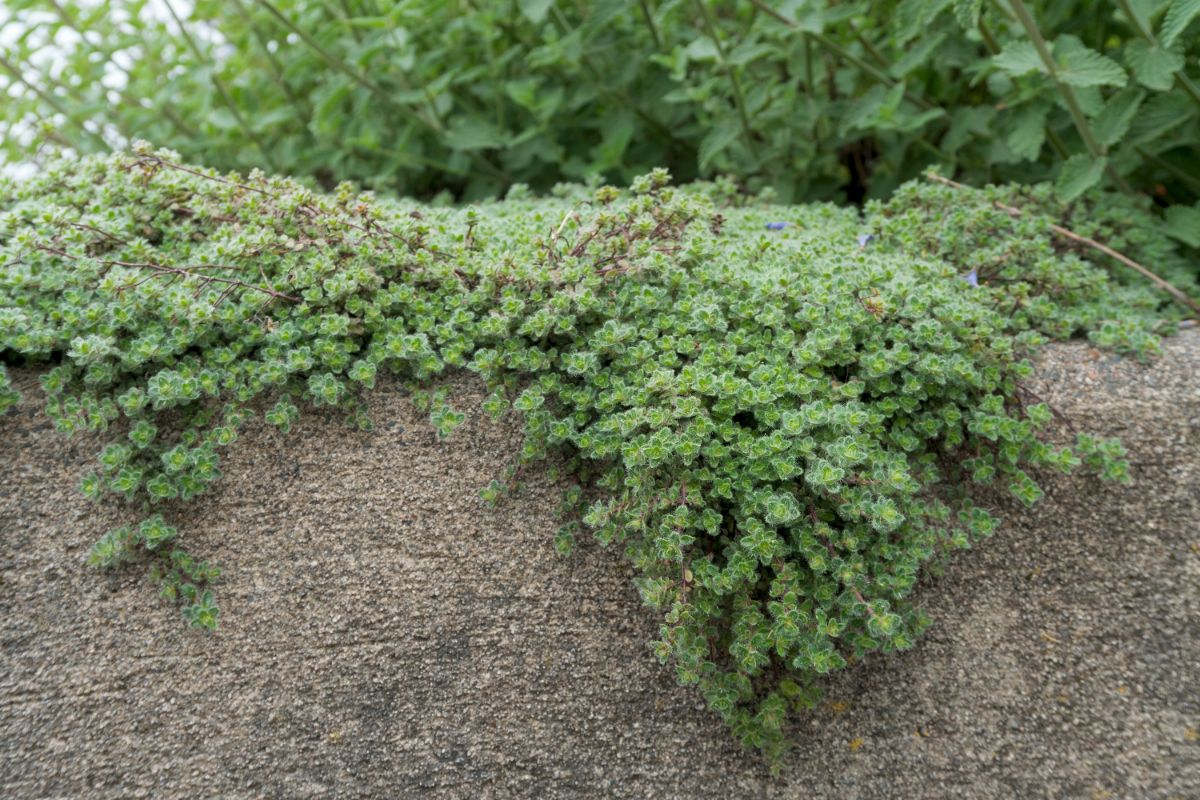
| Plant name: | Woolly thyme |
| Light requirements: | Full sun to light shade |
| Watering requirements: | Moderate to low |
| Growing zone: | Zones 4 to 7 |
| Notable features: | Hairy stems; Low maintenance, edible groundcover |
Creeping thyme is also sometimes called woolly thyme, which can lead to a lot of confusion among herb growers. However, Thymus pseudolanuginosus, or woolly thyme, is a distinct species of thyme with its own unique set of characteristics. Part of the confusion stems from the fact that woolly thyme has a creeping growth habit, and it can be used as a drought-tolerant groundcover, but this plant is edible too!
Woolly thyme is mostly known for its hairy or woolly stems, but this plant also has lovely, grayish-green leaves and dainty, tubular, purple flowers. Like other thyme plants, woolly thyme is highly attractive to pollinators, and it grows well in dry and arid places. Full-grown plants grow to about 3” tall, and they can spread over a 1’ wide, but thyme plants generally don’t grow very fast during their first year, so you’ll need to be patient while your thyme plants fill in.
10. Mother of thyme (Thymus praecox)
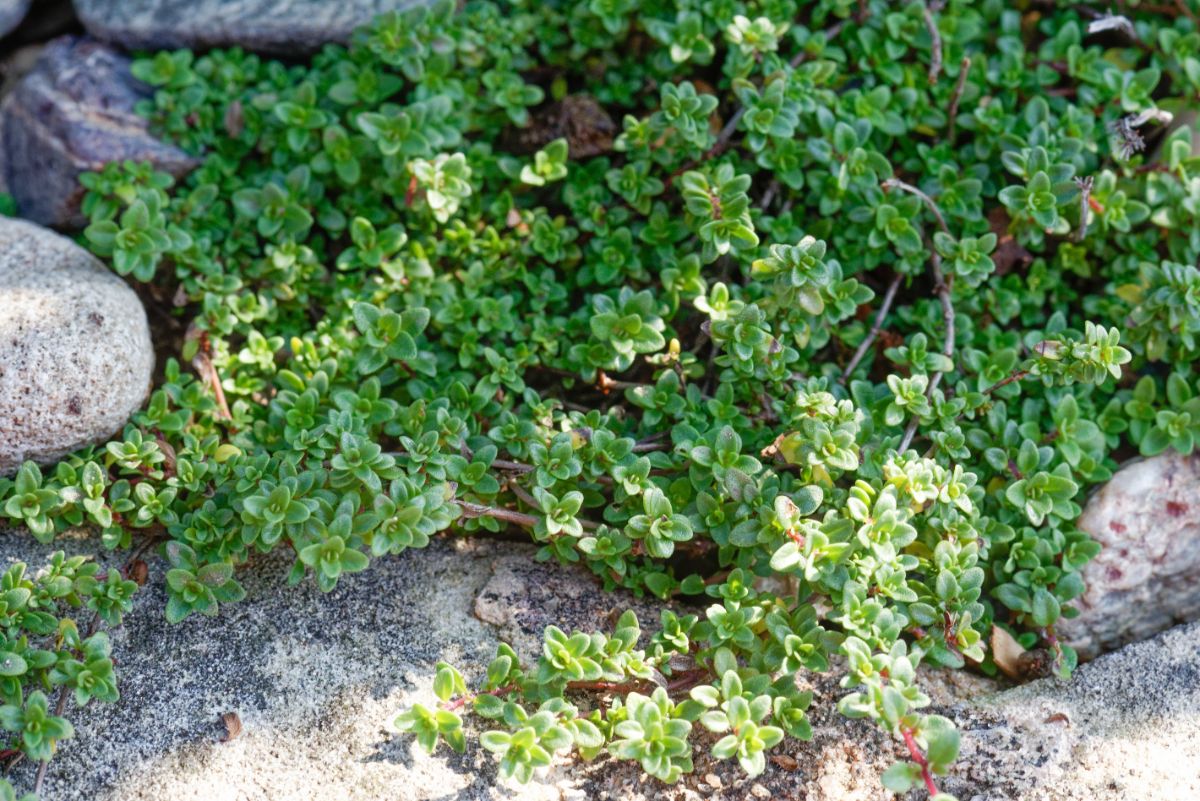
| Plant name: | Mother of thyme |
| Light requirements: | Full sun |
| Watering requirements: | Moderate to low |
| Growing zone: | Zones 4 to 8 |
| Notable features: | Low maintenance, edible groundcover |
Like woolly thyme, mother of thyme is another creeping edible thyme species that’s often used as a groundcover. This plant is also sometimes called “creeping thyme” or “woolly thyme,” so if you want to be sure that you get your hands on a true mother of thyme plant, be sure to check the plant’s Latin name. Another solid choice for rock gardens, mother of thyme can be grown as a drought-resistant lawn covering, and it can be kept in pots too!
Mother of thyme grows from about 2 to 6” tall, but it spreads out wide to cover a lot of earth. In fact, this hardworking plant can be used to keep weeds in check, but it also looks stately when planted along garden walkways and borders. Blooming from June to September, mother of thyme plants produce tons of pinkish-purple flowers, and they have a deep, lemony flavor that’s sure to please.
11. Pennsylvania Dutch tea thyme (Thymus pulegioides)
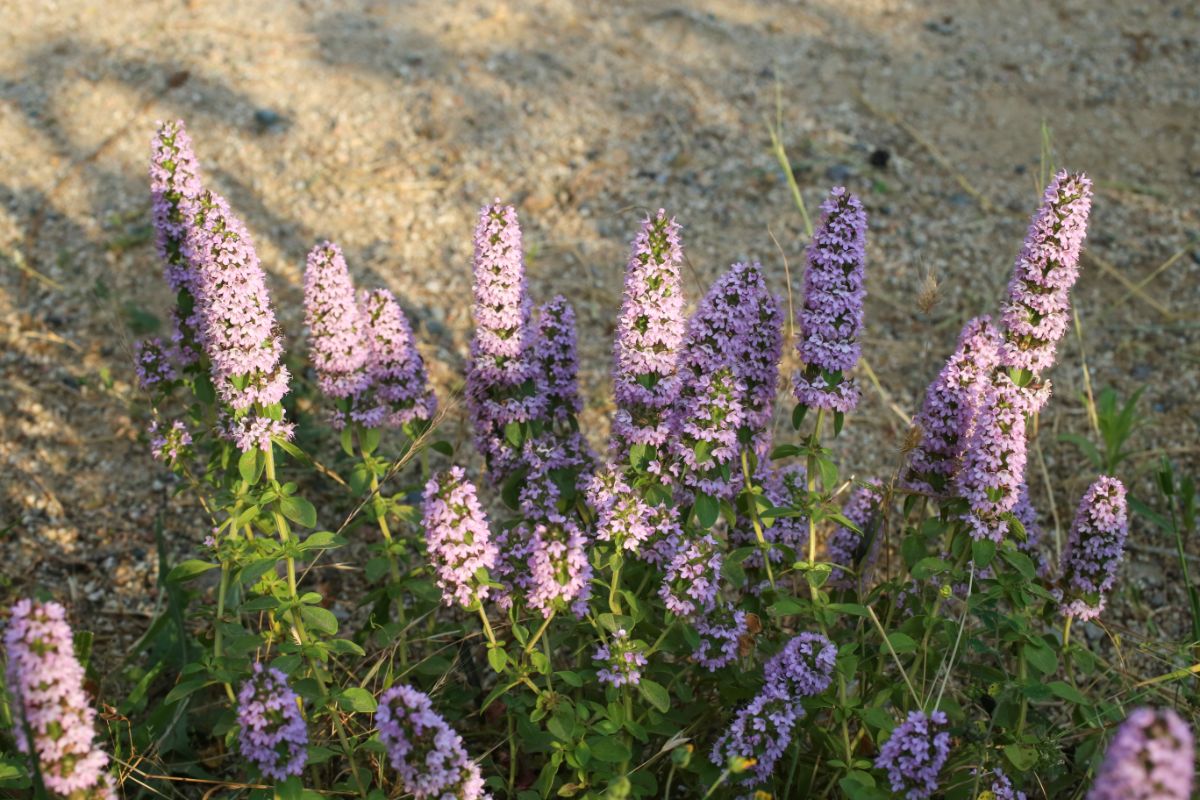
| Plant name: | Pennsylvania Dutch tea thyme |
| Light requirements: | Full sun |
| Watering requirements: | Moderate to low |
| Growing zone: | Zones 5 to 11 |
| Notable features: | Good for herbal teas; Larger leaves |
Sometimes also known as wild thyme, Pennsylvania Dutch tea thyme is a less commonly grown thyme variety that’s native to Europe. This plant can be harder to track down at local plant nurseries, but you can usually order it online if you really want to get your hands on it. Growing up to 12” tall, Pennsylvania Dutch tea thyme is a taller thyme variety, and it has slightly larger, oblong leaves that come in a rich green coloration.
As its name suggests, Pennsylvania Dutch tea thyme was traditionally used to flavor teas, but it has also been used as an edible herb to flavor recipes, and it was once used as a medicinal tool. Like other thyme plants, this thyme variety can be easily propagated by stem cuttings using either soil or water propagation methods. However, in general, woody-stemmed herbs like Pennsylvania Dutch tea thyme are easiest to propagate in soil with a bit of rooting hormone.
12. Juniper thyme (Thymus leucotrichus)
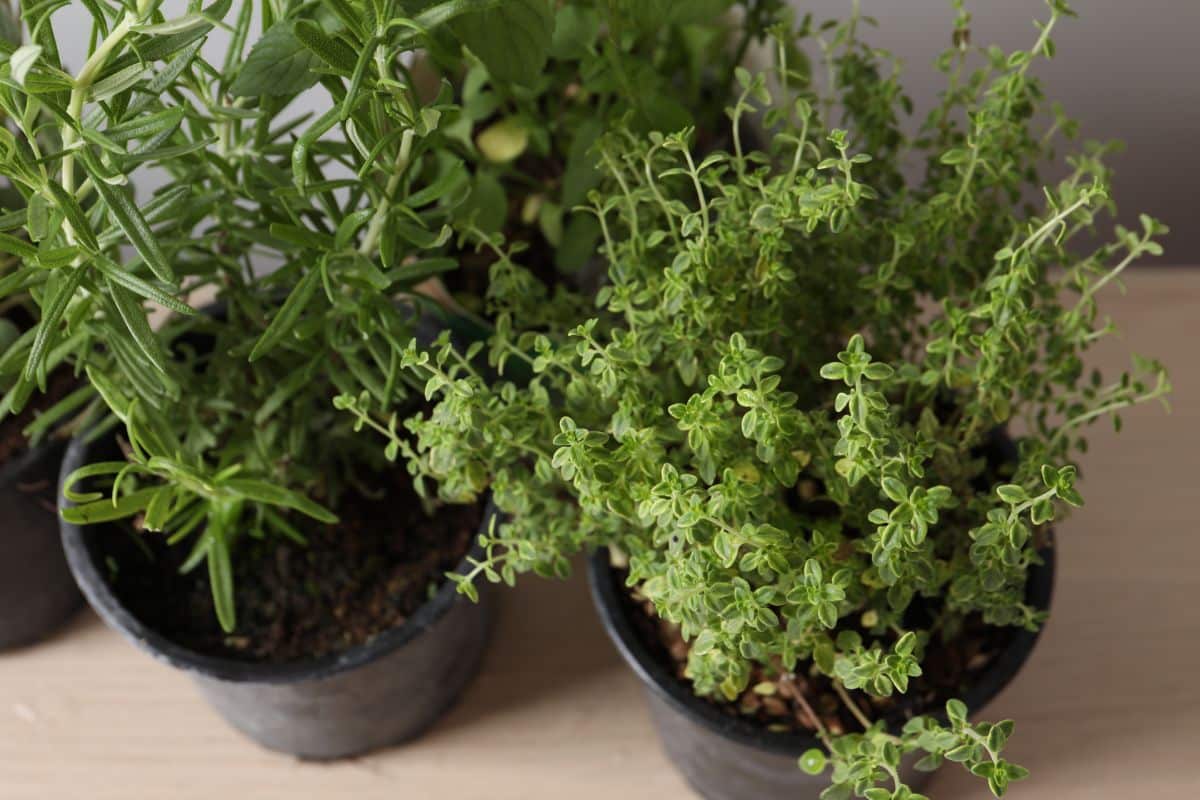
| Plant name: | Juniper thyme |
| Light requirements: | Full sun |
| Watering requirements: | Moderate to low |
| Growing zone: | Zones 3 to 9 |
| Notable features: | Spicy flavor |
Native to Greece, Syria, and Turkey, juniper thyme is another less common thyme variety, and this one sports a delicious, spicy flavor. Useful in savory dishes and roasted dinners, juniper thyme grows to about 8” high by 12” wide, and it can be grown as a groundcover or kept in herb gardens or patio planters. Easy going and reliable, juniper thyme is hardy from USDA growing zones 3 to 9; however, like other thyme plants, it can be vulnerable to root rot, so make sure your plant isn’t kept in soggy conditions.
Thyme plants can be harvested little by little throughout the growing season by snipping away a thyme sprig or two to use in your favorite recipes. But thyme plants can also be harvested in large quantities, which is useful if you want to dry your herbs. Just remember not to cut back more than ½ of your thyme plants at once, and be sure to leave some green stems behind so your plant has the energy to regrow!
13. Mediterranean thyme (Thymbra spicata)
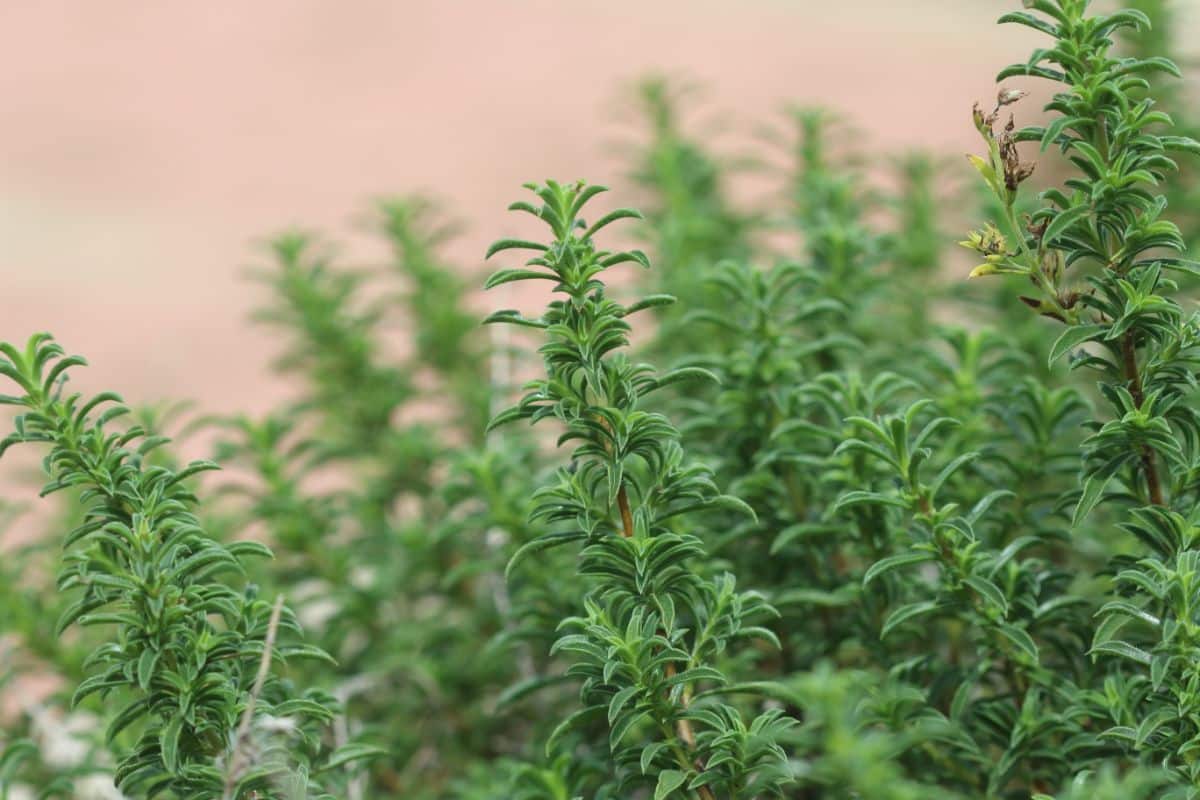
| Plant name: | Za’atar thyme |
| Light requirements: | Full sun |
| Watering requirements: | Moderate to low |
| Growing zone: | Zones 7 to 10 |
| Notable features: | Za’atar substitute |
Also known as Za’atar thyme or spiked thyme, Mediterranean thyme is an interesting choice as it doesn’t belong to the Thymus genus. But like other thyme plants, Mediterranean thyme is a member of the Mint family, and it can be used just like common thyme in many different dishes. Native to Greece, Mediterranean thyme is an excellent choice to grow in xeriscapes and arid garden spaces, but it’s only hardy in growing zones 7 through 10, so it’s not a good choice for chilly climates.
Like other thyme plants, Mediterranean thyme can be used fresh or dried, but many chefs particularly adore the dried leaves, which are similar in flavor to Za’atar. If you want to harvest a lot of thyme at once, consider keeping a rubber band around your wrist and bundling thyme stems as you go. That way, you won’t accidentally drop any of your fresh thyme while harvesting, and you can easily hang the thyme bundle up later for drying!
Frequently asked questions
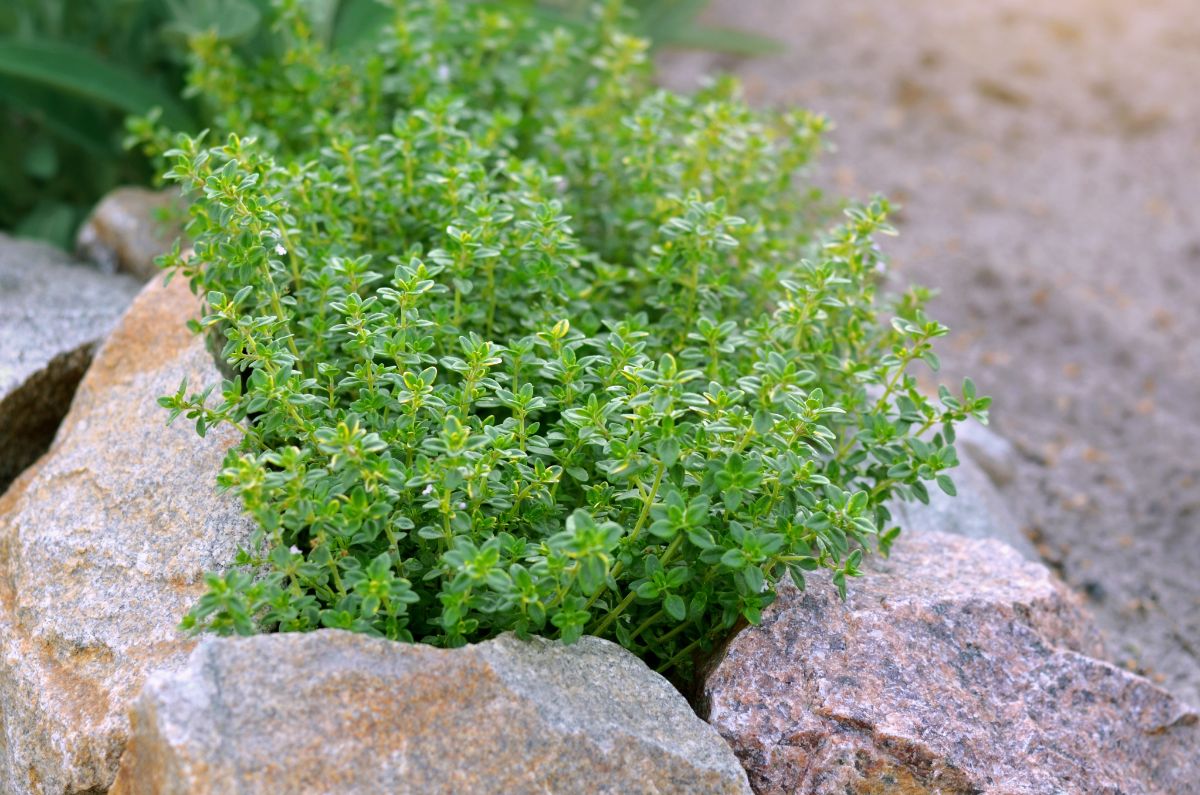
There are over 350 different species of thyme (Thymus spp.), and all of them are edible. However, some types of thyme are more useful for culinary purposes than others. Common thyme, lemon thyme, and orange balsam thyme are particularly noteworthy edible thyme species, while creeping thymes are more commonly used for ornamental purposes.
Common thyme is most often used for tea making, but other types of thyme can also be brewed into hot and cold teas. One traditional thyme type for tea making is Pennsylvania Dutch tea thyme, which has broader leaves than most other thyme varieties.
Small quantities of thyme can be harvested as needed throughout the growing season; however, large harvests of thyme should be more limited. If you want to harvest a lot of thyme at once for drying, the best time to do it is in spring and again in early summer, immediately before the plant flowers. Thyme plants can be harvested again, if needed, in August, but they shouldn’t be harvested too late in the season as this can leave plants vulnerable to fall frosts.
Yes! As long as you don’t overprune thyme plants, thyme plants benefit from frequent harvesting, and they actually grow bushier and fuller if you cut them back from time to time. Just be sure not to harvest more than ½ half of your plant’s stems in one go.
Thyme plants should be ready to harvest when they’re at least 5” tall and growing vigorously. For the best flavor, aim to harvest your thyme right before the plant flowers, as thyme leaves will contain the highest concentration of flavorful oils at this time of the growing season.
Thyme can be kept fresh in your fridge for about 2 weeks by wrapping thyme sprigs in plastic or beeswax wraps. However, if you want to keep thyme even longer, try freezing thyme leaves in ice cube trays or drying thyme sprigs in a food dehydrator. Thyme can also be hang-dried in a cool, dark, and dry place for about 1 to 2 weeks until the plant’s leaves can be easily crumbled between your fingers.
Summary

While common thyme is a classic, if you’re craving different thyme-y flavors or you’re looking for a plant with more colorful leaves, flowers, or an intriguing growing habit, there are many other thyme plants to try. Most thyme types grow equally well in large herb gardens or small space containers, so the real question is which thyme variety intrigues you most of all. And, of course, if you can’t decide, there’s no reason why you can’t grow them all!
If you enjoyed this article and would like to learn more about other herb varieties to grow at home, check out our guide on the different types of lavender to keep in home gardens!

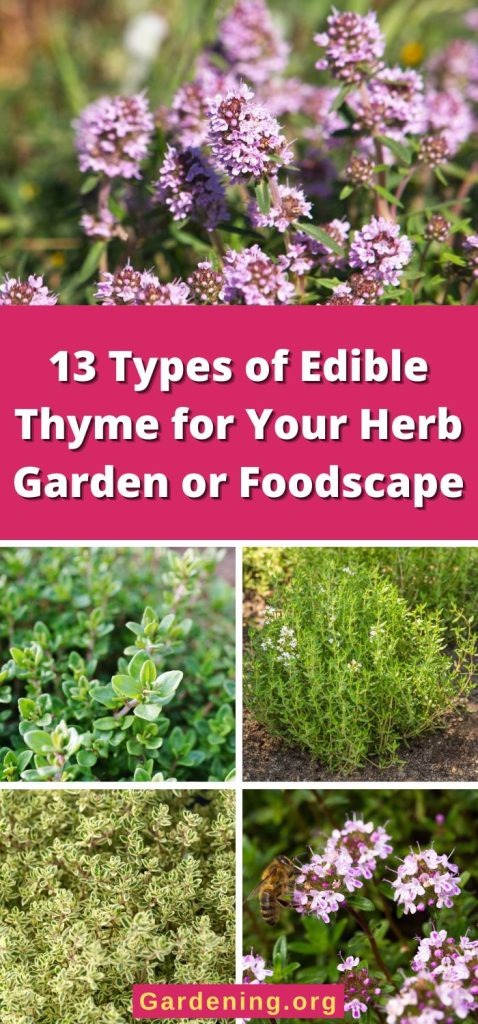

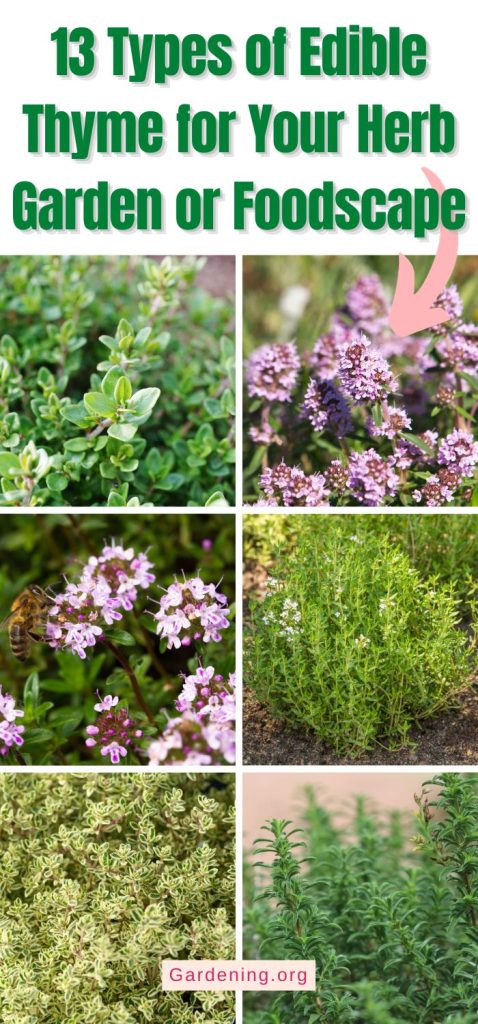
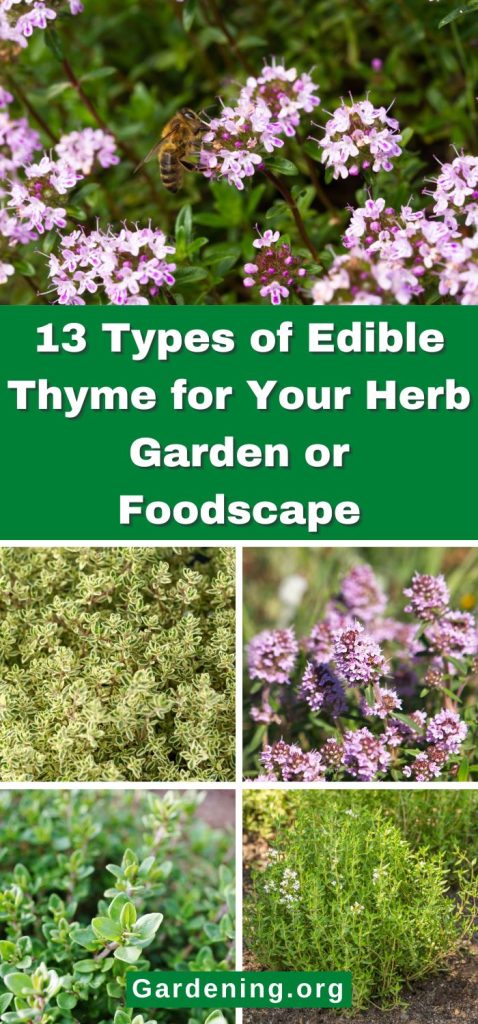

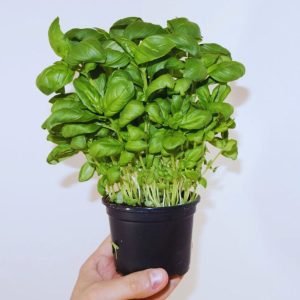

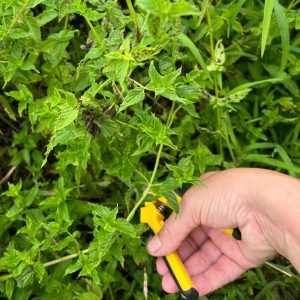
Leave a Reply